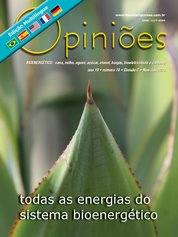Ricardo Lopes Silva
Diretor Agrícola da Raízen
OpAA74
Soluções para operações agrícolas: melhoria do solo e da matéria-prima
O setor sucroenergético tem sido marcado por um cenário de crescimento e transformação. Na safra 2021/22, o valor da produção agrícola no Brasil atingiu o recorde de R$ 743,3 bilhões em 2021, um aumento de 58,6% em relação ao ano anterior. No País onde a cana-de-açúcar é a principal matéria-prima para a produção de açúcar e etanol – já tendo evoluído também para a geração de eletricidade e outros derivados –, seu conceito vem se adaptando com o tempo, mudando de usina canavieira para unidades produtivas, biofábricas, biorrefinarias ou, mais recentemente, parques de bioenergia.
Uma das principais mudanças ocorridas no setor, porém, é o aprimoramento do manejo da cultura que, na busca por métodos de produção sustentáveis, vem investindo em novas práticas. O incentivo à sustentabilidade e à tecnologia no campo está se mostrando fundamental para favorecer o desempenho produtivo da cana-de-açúcar, reduzir custos e minimizar o impacto ambiental das operações. Hoje, mais do que nunca, é preciso respeitar as características do solo e implantar métodos mais eficientes de conservação, sempre observando cada realidade produtiva, definindo o período ideal de corte das áreas e critérios varietais, operacionais e logísticos.
Uma abordagem sustentável da agricultura busca utilizar os recursos naturais, de forma que, a partir dela, atividades como aplicação de defensivos agrícolas de irrigação e monitoramento de falhas no plantio se tornaram mais eficientes. O Brasil consome 8% de toda a produção mundial de defensivos agrícolas, avaliada em 55 milhões de toneladas, mas importa 85% do insumo usado pelo agronegócio, principalmente da Rússia, que sofre um forte embargo econômico promovido pelos Estados Unidos, países da Europa ocidental e Japão, por causa da guerra na Ucrânia. Atualmente, adubos feitos com resíduos da cana-de-açúcar prometem ampliar a produtividade e reduzir os impactos ambientais do cultivo de diversas matérias-primas. Na cana-de-açúcar, o uso de vinhaça e torta de filtro, principais resíduos da indústria sucroenergética, vem sendo intensificado cada vez mais.
A fim de reaproveitar a maior quantidade possível do que sobra nos canaviais, já existem sistemas que permitem a utilização da torta de filtro compostada, enriquecida com minerais e microrganismos. Com esse adubo organomineral, é possível substituir a aplicação de fertilizantes de origem mineral e fóssil, tornando o manejo mais sustentável, já que reduz interferências químicas no solo.
Num contexto em que é cada vez mais necessário garantir a eficiência no uso da água, a irrigação é um dos fatores que podem ajudar com que uma lavoura alcance o máximo de seu potencial produtivo. Fatores como o manejo da irrigação e a utilização de ferramentas, como dados de estações meteorológicas, instalações de sensores de solo e manutenções preventivas para evitar eventuais vazamentos, podem influenciar em até 30% a redução no consumo total de água nos canaviais. A exemplo disso, a estimativa é que as áreas irrigadas por gotejamento produzam, em média, cerca de 40 toneladas de cana a mais em comparação com a lavoura de sequeiro, sem contar a maior longevidade – tempo de permanência da cultura em campo –, que pode durar até 5 anos a mais.
O gotejamento, método de irrigação mais utilizado, se comparado a outros procedimentos (superfície, microaspersão ou convencional), ganha espaço porque tem como vantagem a redução do consumo de água ao evitar a evaporação e o escoamento superficial, aspectos alcançados a partir do funcionamento de baixa pressão e que beneficiam a estabilização da produtividade no decorrer dos anos. Por meio do aumento de produtividade, uso racional da água e baixo consumo de energia elétrica, a irrigação ajuda a otimizar custos para produzir mais toneladas de cana, assim como elevar a eficiência nos processos.
Em termos de otimização de recursos e benefícios sustentáveis para a cadeia da cana-de-açúcar, há, ainda, o controle biológico, que regula a população de organismos vivos que causam danos à cultura. A solução é uma estratégia viável, eficiente e de baixo custo, especialmente para os dois tipos de pragas que mais atacam a cana-de-açúcar: a broca e a cigarrinha-das-raízes, que podem devastar canaviais inteiros. As principais formas para eliminar este tipo de praga são por meio do controle químico e biológico, mas, hoje, já existem tecnologias que fazem a distribuição de moscas predadoras nos canaviais dentro de cápsulas biodegradáveis lançadas por drones, fazendo com que seja possível minimizar o impacto causado ao solo, ao meio ambiente e à plantação.
Outras muitas soluções se destacam: ampliação do uso da vinhaça, que otimiza o uso dos recursos hídricos e insumos agrícolas; a rotação de culturas, com a alternância planejada em uma mesma área; os corretivos, que permitem equilíbrio do pH do solo e absorção de nutrientes para as culturas; bioestimulantes, prática de manejo que pode incentivar a produtividade dos canaviais se aliada à manutenção fisiológica da cana; entre outros benefícios.
O setor sucroenergético se posiciona de maneira estratégica diante da demanda crescente por fontes de energia alternativas ao petróleo e derivados, mas, para produzir outros produtos, é necessária uma cana da qualidade. Agregar implementos e tecnologia de ponta é importante, mas o que garantirá maior eficiência e determinará o desenvolvimento de novas soluções é alcançar os “três dígitos” na cana, o cuidado com a terra e o melhor aproveitamento dos insumos.
O importante, sobretudo, é realizar as operações com o foco na produção, sem esquecer a importância da manutenção dos recursos produtivos.




